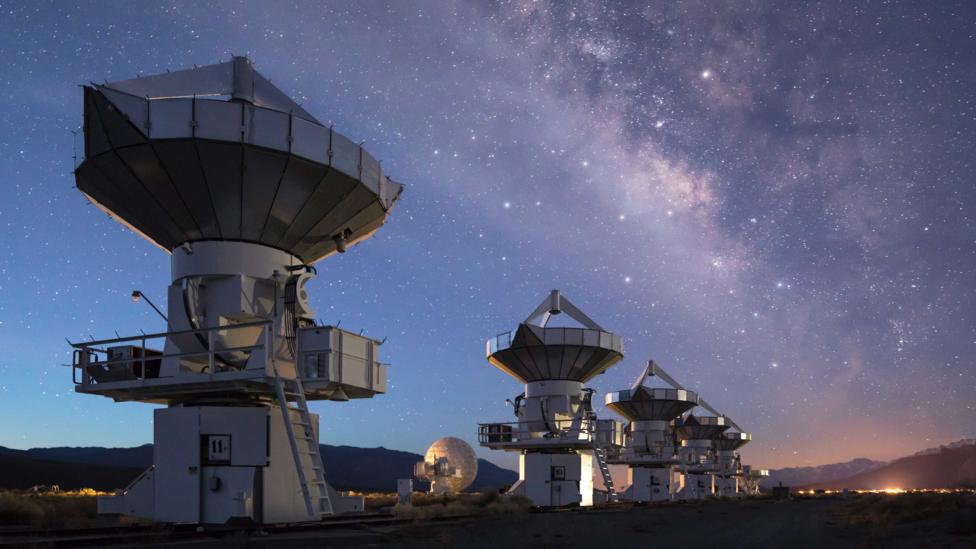Can we actually say anything about the far future? If we can’t predict when it will rain next month, forecasting billions of years hence might seem impossible.
However, not everything is as chaotic as the weather: even predictions very far ahead are sometimes possible, especially in astrophysics and cosmology. We can be confident that there will be a total solar eclipse in the UK on 23 September 2090 because the Moon,
Sun and Earth move in stable, predictable orbits with very minor disturbances, and the laws of gravity are now well-tested. Similarly, we can use known astrophysics to predict what will likely happen across the Universe as it expands.
You might also like:
• The perils of short-termism
• Are we on the road to civilisation collapse?
• How to build to last 10,000 years
This approach can be described as “physical eschatology” – a term coined by the astronomer Martin Rees for using astrophysics to model where the Universe is going. Rees took a cue from theology, in which “eschatology” is the study of ultimate things such as the end of the world. And the classic paper on the topic is Freeman Dyson’s 1979 paper on life in open universes, which outlined likely or possible existential catastrophes that could threaten life far into the future, from the death of the Sun to the detachment of stars from galaxies.
So, what are the biggest challenges humanity will face if we survive into the far future? We cannot say how (or if) they will be overcome (I will make some guesses) but we can be confident these threats to our existence are coming.
Problem 1: Survive better than other mammals
The typical lifespan of a mammalian species is about a million years or so. From nuclear war to bioengineered pandemics, humanity clearly has other risks it needs to reduce urgently: right now the natural extinction rate is far smaller than risk we pose to ourselves.
Were we to fix our current existential risk and sustainability problems we would still have to deal with some other challenges to stay around.

Can we outlive the typical lifespan of mammalian species? (Credit: Getty Images)
We may also face dramatic climate variations between different geological eras. In the past the Earth has been not just colder, but also warmer. During the Eocene, temperatures were 10C warmer, with palms and alligators in the Arctic and equatorial regions too hot for unprotected humans to survive in. Even further in the past there has been “snowball Earth” episodes where almost all of the Earth was covered with ice.
Homo Sapiens may not endure as a species because we could evolve into something else
Then there is the risk of supervolcanism, meteor impacts, gamma ray bursts, or emergent ecological disruptions, which we know have led to natural mass extinctions about once every 100 million years.
Ultimately, Homo Sapiens may not endure as a species because we could evolve into something else. We are constantly mutating and subject to natural selection (even today with good healthcare, road accidents are slowly selecting away people likely to kill themselves in traffic while young), and modern biotechnology allows us to modify our genes deliberately. Not to mention technologies that allow us to merge with the artificial. Over millions of years it is unlikely that we will stay the same – unless we make a deliberate decision to preserve our genetics and can make that decision stick over geological timescale.
If “we” are around in a billion years from now, we would have arbitrarily sustainable civilisations able to handle disasters on a planetary scale, plan ahead for geologic time, and likely be as different from us as we are from the trilobites. The irony is that to survive longer than our fellow mammalian species, we have to become something very different from what we are.
Problem 2: Survive the end of the biosphere lifespan
In about a billion years (give or take a few hundred million years) the increased brightness of the Sun will doom the Earth’s biosphere.
The problem is that the heat of the Sun leads to increased weathering of rock, which in turn leads to chemical reactions that removes significant amounts of carbon dioxide from the air as part of the carbon cycle, eventually starving plant-life. In addition, the planet eventually overheats as a runaway greenhouse, with more and more water vapour (a potent greenhouse gas) evaporating from the oceans, making it even hotter.

An ever-brightening Sun could cause our descendants serious problems (Credit: Getty Images)
One approach is to try to protect the biosphere with megascale engineering for as long as possible. We may perform geoengineering by adding reflective aerosols to the stratosphere, build a solar shade between the Earth and Sun, or even move the planet outwards.
Another solution is to move life into space, if we have not already done so. Self-sustaining space habitats appear possible, and there is material out there for many billion times the Earth’s surface area. Even if these structures appear hard to build, we should remember that we literally have a billion years to become more skilled, richer, and to work on them.
By this point humanity has to be an actor on the scale of the Solar System if it is to survive.
Problem 3: Survive the end of the Sun’s main sequence lifetime
In around 5 billion years, the Sun’s brightness will start to increase more rapidly because accumulated helium in the core will heat it up, turning it into an enormous red giant. The surface temperature goes down but the total light output is far larger due to the huge surface area. This likely spells the end for the Earth, since it is likely to be swallowed by the Sun as it expands. If it isn’t, it will be fried to an airless rock. “Soon” after (a billion years or so) the Sun will expel much of its atmosphere as a nebula and becomes a tiny white dwarf.
To survive this, any intelligent life living in the Solar System will need to move to other solar systems.
Reaching other solar systems will either require very fast spacecraft, or will take a long time.
To people already living on self-sufficient space habitats, setting them in motion towards new destinations might be fairly natural. They would need energy sources that could last for a long time (not to mention to give them a decent speed) and enough material to maintain the habitat for the multi-millennia transit.
The most likely way to get to the stars might, however, be tiny nanorobot spacecraft. Instead of using vast energy to push giant starships to a modest velocity, it might be better used to send tiny craft fast using a reflective sail and a powerful laser. They are small and redundant: if one does not make it, send a thousand. They could also carry the genetic elements to create life – even human beings. once they arrive, they land on a suitable asteroid, unfold solar collectors, mine material and build more robots, solar collectors and factories. Eventually they can build habitats and nurture people to live in them.

Moving to space may be our chance of very long-term survival (Credit: Getty Images)
It might well be that no biological human will ever physically leave the Solar System. At this point we might question whether it is actually our humanity or a new species that is spreading. But if our descendants survive the red giant Sun they will now be living among the stars of the galaxy.
Problem 4: Survive the end of stars
Star formation in the Universe has already peaked and in the next few tens of billions of years we will reach “peak star”. As the bright and short-lived stars burn out, we will be left with a staid but long-lived population of red dwarf stars. They can shine for trillions of years. But star formation will decline, and in 10-100 trillion years even the red dwarfs will sputter and go out. To survive, life will need energy sources other than starlight.
Star formation will decline, and in 10-100 trillion years even the red dwarfs will sputter and go out
There are actually many possibilities: fusion using hydrogen from brown dwarfs and gas planets, dumping matter into black hole accretion disks and gathering the released energy, or even tapping black hole rotation directly using so-called super-radiant scattering (known as “black hole bombs”). In any case it will require engineering on a vast scale. What about normal nuclear power? Fission power will end when there are no new radioisotopes produced by merging neutron stars and supernovas, which by now are long in the past. Geothermal energy also runs out when the isotopes inside planets decay away and they cool down.
“Life” may also adapt to low temperatures and exotic environments. Artificial intelligence and silicon-based organisms would probably thrive in the near absolute zero temperature environment. It might well be that as the stars go out, carbon-based life and intelligence retreats into comfortable virtual worlds far bigger and more complex than the external Universe ever was.
If humanity survives the end of the stars, it will be the largest energy source in the Universe.
Problem 5: Survive the end of galaxies
Random stellar motions eventually cause galaxies to dissolve: from time to time stars pass by each other and change velocities randomly. Sometimes this gives a star an escape velocity from the galaxy and it disappears out into the great emptiness, leaving the rest of the galaxy slightly more condensed. Eventually – in about 100 million trillion years – all of the galaxy scatters or falls into the central black hole. Planets around the stars will also be flung away in the close encounters.
To survive this, intelligent beings need to steer stars to put them into orbits that are long-term stable.
This looks physically possible! At least in the present era, one could nudge stars by placing reflectors so their radiation acts as very weak rocket engines, getting them to pass by each other in a controlled fashion. This is similar to how we humans used gravity assists to redirect and accelerate the Voyager probes, but now on a vast scale. As the stars change orbits they could be used to further nudge each other in the largest billiard game ever conceived.

In the next few tens of billions of years we will reach 'peak star' (Credit: Getty Images)
It would take big structures around every star and massive planning ahead, but the total amount of matter needed is about a big asteroid per solar system and the physics is relatively straightforward. The issue is more about coordinating projects on literally billion year timescales. Which by this time might be everyday planning for a humanity that has already handled the past problems.
Problem 6: Survive the end of matter
Our kind of matter is built out of atoms composed of protons, neutrons and electrons. Protons and electrons are normally said to be perfectly stable (the neutrons are stabilised by the protons; on their own they decay with a half-life of a few minutes).
However, many physical theories predict that protons are not truly stable and will decay over enormously long timespans. Proton decay has never been observed so far despite some heroic research efforts. But this merely tells us that it takes trillions of years, if it happens.
This decay will spell the end of matter as we know it. Stars and planets will slowly turn into radiation plus free electrons and positrons, unable to form habitable systems. The last cold black dwarf stars would gradually turn into helium and hydrogen crystals that quietly evaporate in stillness. The only thing left would be radiation and black holes in an otherwise empty Universe.
Can we get around it? As the great computer in Isaac Asimov’s masterful short story “The Last Question” said, "THERE IS AS YET INSUFFICIENT DATA FOR A MEANINGFUL ANSWER."
--
Anders Sandberg is a researcher based at the Future of Humanity Institute, University of Oxford. He tweets @anderssandberg.
Join more than one million Future fans by liking us on Facebook, or follow us on Twitter or Instagram.
If you liked this story, sign up for the weekly bbc.com features newsletter, called “The Essential List”. A handpicked selection of stories from BBC Future, Culture, Capital, and Travel, delivered to your inbox every Friday.




